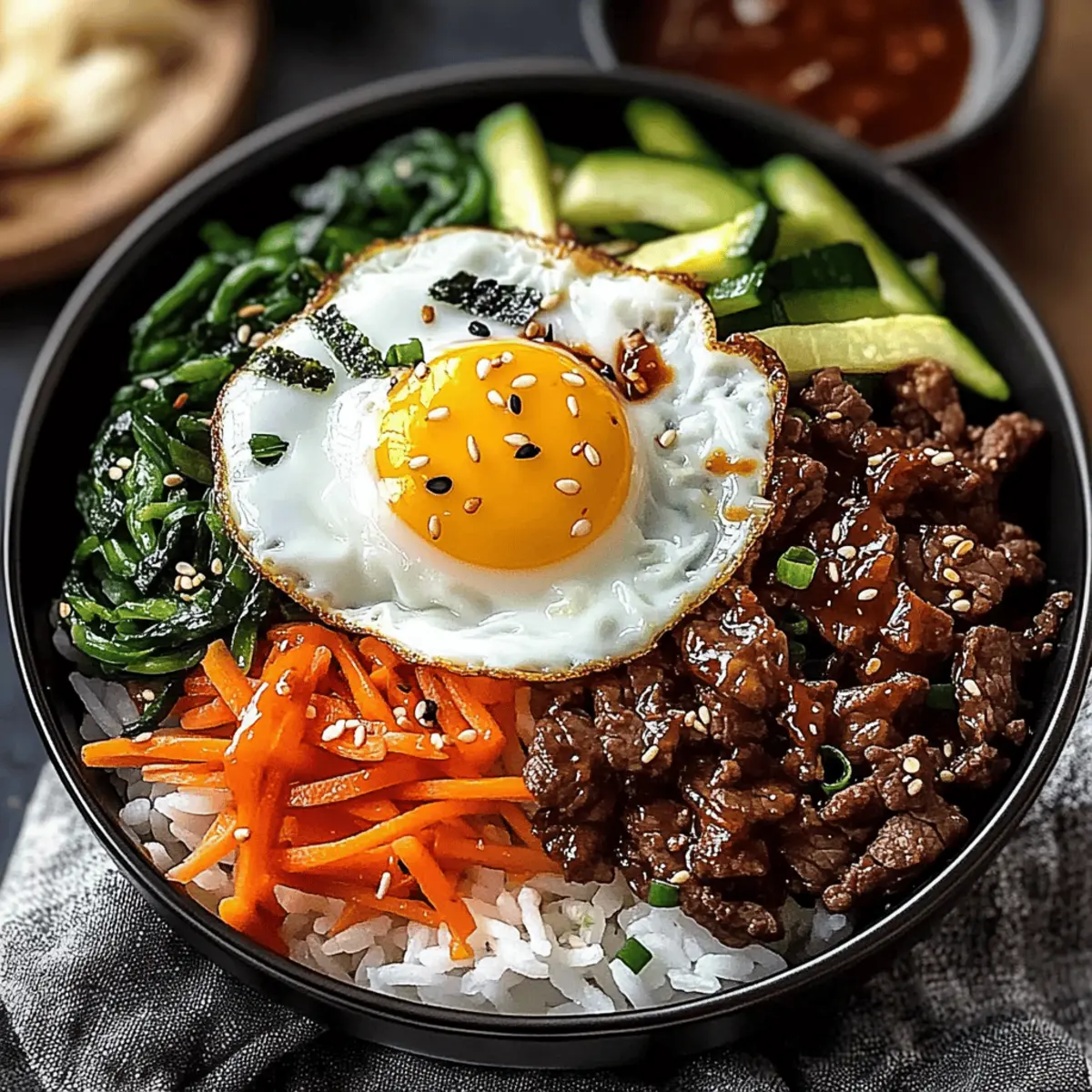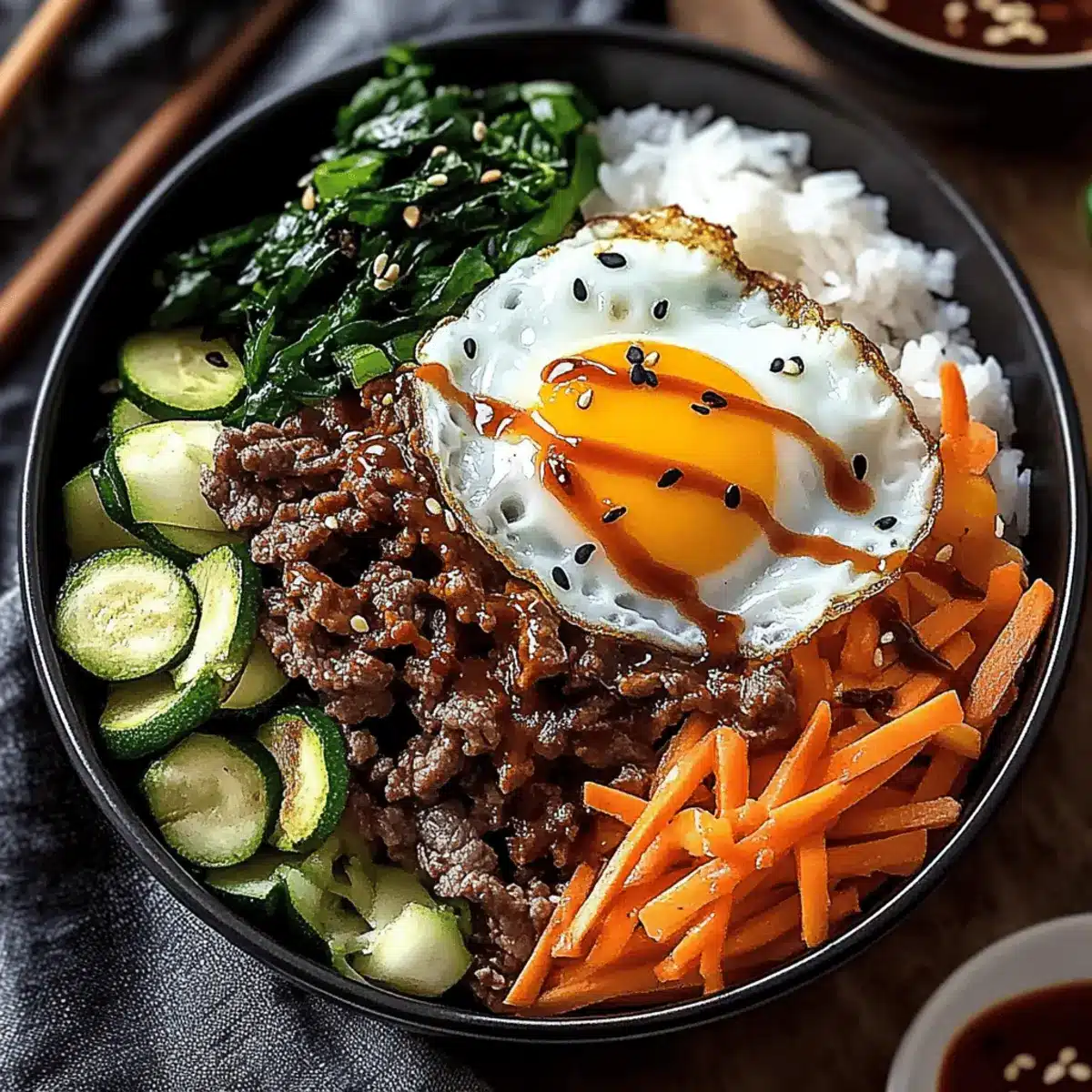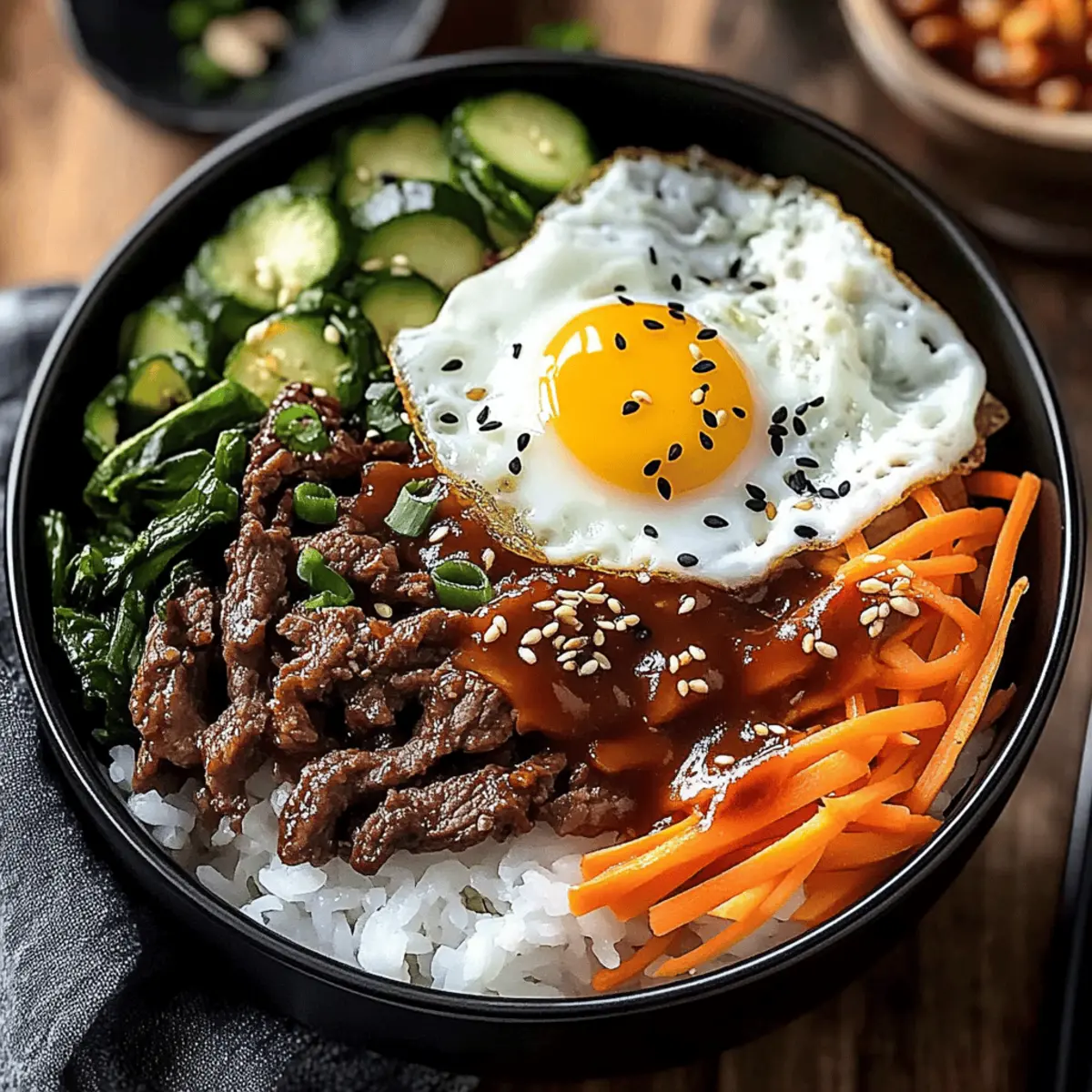As the sizzling sounds of marinated beef hit the hot skillet, I can’t help but smile at the comforting aromas swirling around my kitchen. Today, I’m thrilled to share my take on a Korean classic, the Korean Beef Bibimbap Bowl. This vibrant dish is not only a feast for the eyes but also a quick, customizable meal perfect for busy weeknights or impressing friends at a gathering. Picture luscious ground beef paired with colorful vegetables and a perfectly fried egg, all nestled atop sticky short-grain rice. Best of all, this recipe easily adapts to suit vegetarian tastes too. Are you ready to dive into a bowl of flavor-packed goodness that promises to brighten your day? Let’s get cooking!

Why is Bibimbap a beloved dish?
Vibrant and Colorful: The Korean Beef Bibimbap Bowl is a visual delight, with its array of colorful vegetables and toppings that make each bite a feast for the eyes as well as the taste buds.
Quick Cooking: Perfect for busy evenings, this dish comes together in no time, letting you enjoy a homemade meal without the hassle.
Customizable Options: Feel free to experiment! You can easily swap out ingredients, whether you want to make it vegetarian by using tofu or tempeh or adjust the spice level of the gochujang to suit your palate.
Culinary Adventure: Embrace the rich flavors of Korean cuisine right in your kitchen, and pair it with delicious side dishes, like Korean Bbq Steak or kimchi, for a full experience.
Nutritionally Balanced: With a wholesome mix of protein, carbs, and vitamins, each bowl is not only satisfying but also nutritious, making it perfect for family meals.
Dig into this quick, colorful comfort food today!
Korean Beef Bibimbap Bowl Ingredients
For the Beef
- Ground Beef – Provides savory protein; substitute with tofu or tempeh for a vegetarian option.
- Gochujang Sauce – Adds heat and umami flavor; adjust quantity for your spice preference.
- Low-Sodium Soy Sauce – Enhances umami taste while controlling sodium intake; tamari is a gluten-free alternative.
- Sesame Oil – Provides richness and nutty flavor; olive oil can be used as a substitute.
For the Rice
- Short-Grain White Rice – Acts as the hearty base; essential for authentic texture; avoid long-grain varieties.
For the Vegetables
- Carrots – Add sweetness and crunch; can be substituted with bell peppers for a similar texture.
- Spinach – Offers freshness and nutrition; kale can be used in its place.
- Zucchini – Contributes a mild flavor and moisture; yellow squash can be a suitable alternative.
- Bean Sprouts – Provide crunch and hydration; can be replaced with shredded cabbage.
For the Topping
- Eggs – Serve as a rich topping for added protein; could be replaced with sliced avocado for a vegan option.
Elevate your meal today with this colorful Korean Beef Bibimbap Bowl!
Step‑by‑Step Instructions for Korean Beef Bibimbap Bowl
Step 1: Prepare the Rice
Begin by rinsing 1 cup of short-grain white rice under cold water until the water runs clear. This removes excess starch for the ideal sticky texture. Cook the rice in a rice cooker or on the stovetop with 1.5 cups of water over medium heat. Once it reaches a boil, reduce the heat to low, cover, and cook for about 18 minutes until tender. Fluff with a fork and set aside.
Step 2: Cook the Beef
In a large skillet, heat 1 tablespoon of sesame oil over medium-high heat. Add 1 pound of ground beef and cook for 5–7 minutes, breaking it up with a spatula until it’s browned and no longer pink. Drain any excess fat from the pan. You want the beef to be well-cooked and flavorful, which lays a hearty foundation for your Korean Beef Bibimbap Bowl.
Step 3: Flavor the Beef
Reduce the heat to low and stir in 2 tablespoons of gochujang, 1 tablespoon of low-sodium soy sauce, and 1 teaspoon of sesame oil. Let this mixture simmer for 5 minutes, stirring occasionally to combine the flavors. The beef should be evenly coated and glossy, giving it a rich color that enhances the overall presentation of your bibimbap bowl.
Step 4: Sauté Vegetables
In a separate pan, heat 1 tablespoon of vegetable oil over medium heat. Add 1 cup of julienned carrots, 1 cup of sliced zucchini, 1 cup of spinach, and 1 cup of bean sprouts. Sauté for about 7 minutes, stirring frequently, until the vegetables are tender yet still crisp. You want the vibrant colors to pop, creating a beautiful contrast against the beef.
Step 5: Fry Eggs
In a non-stick skillet, heat a little oil over medium heat. Crack 2 eggs gently into the pan and cook for about 3 minutes or until the egg whites are set but the yolks remain runny. This sunny-side-up style adds a rich creaminess to the top of your Korean Beef Bibimbap Bowl, making it even more delicious and appetizing.
Step 6: Assemble Bowls
To assemble your Korean Beef Bibimbap Bowl, start with a generous scoop of the cooked rice at the bottom. Layer the flavorful beef mixture, followed by the sautéed vegetables, ensuring even distribution of colors and textures. Top each bowl with a beautifully fried egg and, if desired, drizzle over additional gochujang or sprinkle sesame seeds. Serve immediately for the freshest taste!

Korean Beef Bibimbap Bowl Variations
Feel free to let your culinary creativity flow and make this dish your own with these fun variations!
-
Vegetarian Delight: Swap ground beef for tofu or tempeh, seasoned with gochujang for a hearty vegan option. This twist maintains the spirit of bibimbap while catering to plant-based eaters.
-
Spicy Kick: Add sliced jalapeños or a dash of chili flakes to your beef mix for an extra layer of heat. Just a little spice can elevate flavors and give your dish a good punch!
-
Seasonal Veggies: Incorporate seasonal vegetables like asparagus or radishes to add freshness and crunch. Embrace the produce available in your area for a rotating taste experience.
-
Rice Alternatives: Try quinoa or cauliflower rice as a base for a gluten-free or lower-carb version. These options maintain a satisfying texture while changing the dish’s overall feel.
-
Flavor Fusion: Experiment with adding Korean BBQ flavors by using marinated beef. Check out this delightful Korean Bbq Steak recipe for inspiration on how to season your protein differently.
-
Nutty Flavor Boost: Top your finished bowl with a sprinkle of crushed peanuts or walnuts for added crunch and a delightful nutty flavor. It’s a simple swap that transforms the dish into a unique experience.
-
Creamy Avocado: Substitute the fried egg with sliced avocado for a creamier topping, especially perfect for vegan diets. The buttery texture complements the other ingredients beautifully.
-
Heat Adjustment: Adjust the amount of gochujang for your preferred spice level, or swap it out for a milder kimchi or spicy sesame dressing for different flavor nuances. Your taste buds will thank you!
These variations allow you to enjoy the essence of the Korean Beef Bibimbap Bowl while tailoring it to your needs. Ready to take your taste journey further? Explore more delicious options like French Onion Beef or Korean Bbq Meatballs for family meals that impress!
Make Ahead Options
These Korean Beef Bibimbap Bowls are a fantastic option for meal prep enthusiasts! You can prepare the rice and beef mixture up to 3 days in advance. Simply cook the rice according to package instructions, let it cool, and store it in an airtight container in the refrigerator. For the beef, brown it, season it, and refrigerate it as well. To maintain quality, sauté the vegetables fresh on the day you intend to serve the bowls. When ready to enjoy, reheat the rice and beef in the microwave, sauté the prepped vegetables briefly, and top with a freshly fried egg. This way, you’ll have a delicious, homemade meal ready with minimal effort!
Expert Tips for Korean Beef Bibimbap Bowl
-
Quality Ingredients: Select high-quality gochujang and fresh vegetables to enhance the flavors in your Korean Beef Bibimbap Bowl. Fresh ingredients make a noticeable difference!
-
Rice Rinse: Rinse the short-grain rice thoroughly before cooking. This step removes excess starch and helps achieve that perfect sticky texture essential for bibimbap.
-
Don’t Rush the Beef: Cook the ground beef until it’s nicely browned and flavorful. Avoid cooking it too quickly to ensure that it develops a rich, savory taste.
-
Vegetable Crunch: Sauté vegetables until they’re tender but still crisp. Overcooking can lead to a mushy texture, which you want to avoid to maintain a good bite.
-
Perfect Runny Yolk: For a beautifully runny fried egg, keep an eye on the cooking time—about three minutes should do the trick. It adds a delightful creaminess to the dish.
How to Store and Freeze Korean Beef Bibimbap Bowl
Fridge: Store leftover components separately in airtight containers for up to 3 days to maintain freshness and texture.
Freezer: For longer storage, freeze the cooked beef and vegetables in airtight bags for up to 2 months. Rice can also be frozen in a separate container.
Reheating: When ready to enjoy, thaw in the fridge overnight or use the microwave. Reheat beef and vegetables until hot, and quickly fry a new egg to top your bowl for the best flavor.
Make-Ahead: Consider prepping ingredients ahead of time. Store chopped vegetables and marinated beef in the fridge for up to a day for a quick assembly during busy nights.
What to Serve with Korean Beef Bibimbap Bowl
There’s nothing quite like pairing a meal with delicious sides that elevate your dining experience and tantalize your taste buds.
-
Kimchi: A quintessential Korean side, this fermented cabbage dish brings a tangy crunch that perfectly balances the hearty bibimbap.
-
Pickled Vegetables: These vibrant, tangy bites offer a refreshing contrast to the richness of the bibimbap, enhancing each mouthful with their zest.
-
Cucumber Salad: Light and refreshing, this salad adds a crisp, cool touch that complements the warm, savory bowl.
-
Sesame Spinach: Rich in flavor, this side dish provides a nutritious element while maintaining the Korean theme, harmonizing beautifully with the main dish.
-
Steamed Dumplings: Fill your table with these deliciously savory bites, offering an inviting pocket of flavor that pairs wonderfully with the rice bowl.
-
Miso Soup: Warm and soothing, this traditional soup adds a comforting element to your meal, creating a well-rounded dining experience.
Make your Korean Beef Bibimbap Bowl a true feast by including these delightful sides that bring a mix of flavors and textures to your table!

Korean Beef Bibimbap Bowl Recipe FAQs
What kind of rice should I use for the Korean Beef Bibimbap Bowl?
You’ll want to use short-grain white rice for an authentic texture. This rice is stickier, allowing it to hold together nicely in the bowl. Avoid long-grain varieties as they don’t provide the same satisfying bite and sticky quality that is characteristic of bibimbap.
How should I store leftover Korean Beef Bibimbap Bowl components?
Store the leftovers in airtight containers in the fridge for up to 3 days. Keep the beef, vegetables, and rice in separate containers to maintain their individual textures. This way, you’ll be able to quickly reassemble your delicious bibimbap bowl later!
Can I freeze the components of the Korean Beef Bibimbap Bowl?
Absolutely! You can freeze cooked beef and sautéed vegetables in airtight freezer bags for up to 2 months. As for the rice, freeze it separately using a sturdy container. When you’re ready to enjoy it, simply thaw the components in the fridge overnight, then reheat before assembling your bowl.
What can I do if my ground beef is too greasy in the Korean Beef Bibimbap Bowl?
If you notice excess fat after cooking the beef, don’t worry! Just drain off the oil carefully before adding your sauces. This helps maintain the flavor without the greasy texture, ensuring a delightful finish to your bibimbap.
Can I make this dish vegan-friendly?
Yes, you can easily adapt the Korean Beef Bibimbap Bowl for a vegan diet! Substitute the ground beef with tofu or tempeh, use sliced avocado instead of eggs, and check that your gochujang and soy sauce are vegan-friendly. These swaps maintain the vibrant flavors while catering to a plant-based lifestyle.
How can I tell if my vegetables are fresh enough for the bibimbap?
Look for vibrant colors and firm textures! If you notice any wilting or dark spots on the vegetables, they may not be fresh. For the best results in your Korean Beef Bibimbap Bowl, choose crisp, bright vegetables that’ll enhance both the flavor and appearance of your dish.

Korean Beef Bibimbap Bowl: Quick, Colorful Comfort Food
Ingredients
Equipment
Method
- Begin by rinsing 1 cup of short-grain white rice under cold water until the water runs clear. Cook rice in a rice cooker or stovetop with 1.5 cups of water over medium heat. Once boiling, reduce to low, cover, and cook for about 18 minutes until tender. Fluff with a fork and set aside.
- In a large skillet, heat 1 tablespoon of sesame oil over medium-high heat. Add 1 pound of ground beef and cook for 5–7 minutes until browned. Drain excess fat.
- Reduce heat to low and stir in 2 tablespoons of gochujang, 1 tablespoon of soy sauce, and 1 teaspoon of sesame oil. Let simmer for 5 minutes, stirring occasionally.
- In a separate pan, heat 1 tablespoon of vegetable oil over medium heat. Add 1 cup each of julienned carrots, sliced zucchini, spinach, and bean sprouts. Sauté for about 7 minutes until tender but still crisp.
- In a non-stick skillet, heat a little oil over medium heat. Crack 2 eggs and cook for about 3 minutes until egg whites are set but yolks remain runny.
- Assemble the bowls by starting with a scoop of cooked rice, layering with beef, sautéed vegetables, and topping with a fried egg. Serve immediately.

Leave a Reply